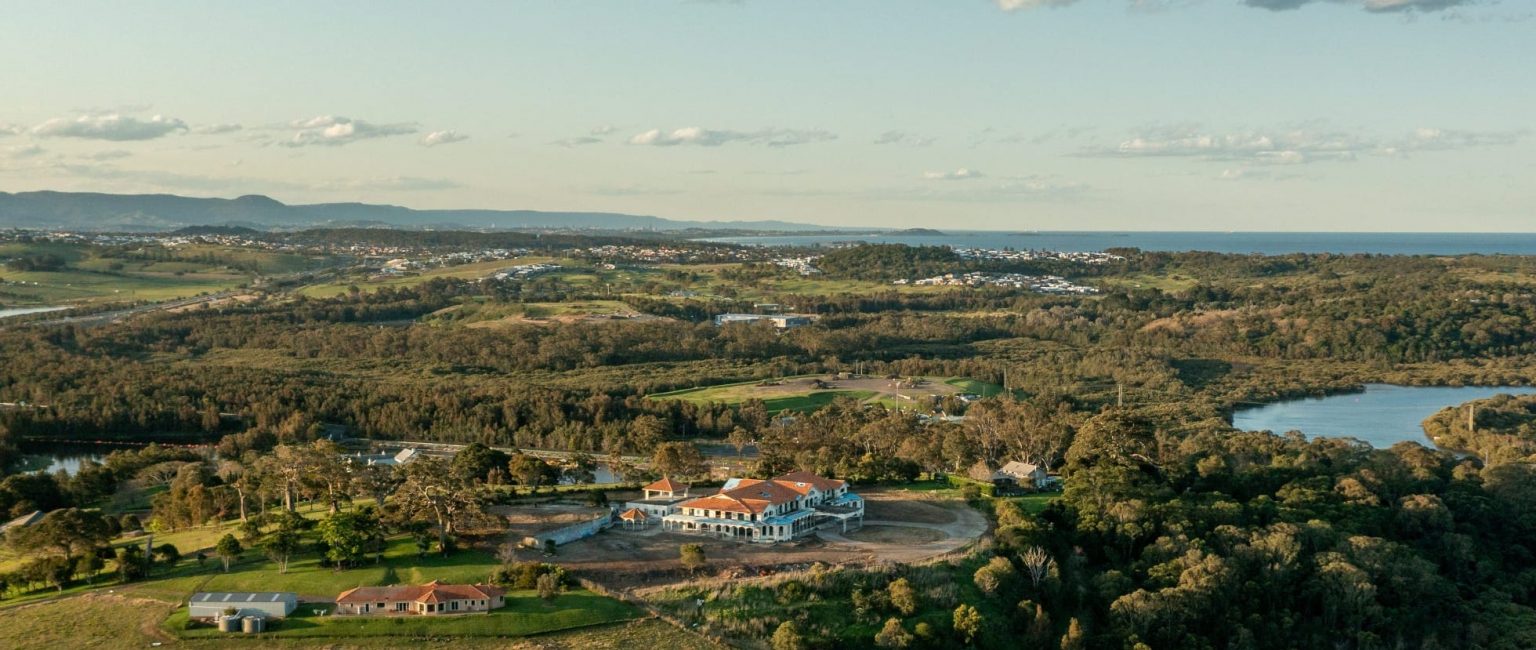Iconic rundown mansion with views hits the market

An imposing and rundown trophy home on the NSW South Coast with approval for an eco-resort is on the market and attracting builders and developers ready to roll their sleeves up.
Palatial in size at 5,000sqm, Minnamurra at 71 Fig Hill Lane, Dunmore, enjoys a hilltop position on 40.47 hectares that takes in spectacular 360-degree views of the ocean to the Illawarra hinterland, with the winding Minnamurra River providing 3.06km of water frontage.
But close up, the mansion isn’t so pretty, reflecting a troubled history that has seen the property remain incomplete, unloved and unoccupied.
The property listing shows stunning location shots and colourful artist renders of how Minnamurra could look as a renovated home or eco-resort, alongside a sole black and white close-up of it presently: covered in graffiti.

The large unfinished property needs some work. Picture: realcommercial.com.au/for-sale
Peter Chittenden at Woodhill Estate Agents, who’s managing the sale, says he’s trying to be “very specific to people” about the work involved.
So far, buyers don’t seem to be put off by the challenge or the $6 million price tag, he says. Since the expressions of interest campaign opened on 5 October, he’s seeing a lot of local interest.
“We’re seeing a huge amount of developers and builders and experts that know that area, as well as people looking to retire,” he said.
He describes the mansion, which is being marketed as both a commercial and residential property, as “crazy with so much opportunity”.
“This is the largest, most private property anywhere down the south coast with enormous views, and right near beautiful empty beaches and the golf course. It is a unique property that will add the person who buys it significant value and lifestyle.”
Troubled history
Wollongong businessman John Kosseris began to build the property around 2005 but his company went into administration and it was bought for an undisclosed sum, allegedly in 2013, from St George Bank by a consortium of Illawarra businessmen, according to previous agents Ray White.
The consortium spent $285,000 on the rundown building to clean it up for sale, with Ray White Kiama selling it to horse breeder Tony Petersen in March for $1.32 million.

The property could become an eco-resort or be renovated and turned into a high-end home for retirement or used as a short-stay accommodation venue for wealthy guests. Picture: realestate.com.au/sold
Mr Petersen joined forces with entrepreneur David Moodie with the aim of creating an eco-resort at Minnamurra. In August 2021 they gained approval for a facility comprising 33 rooms, a gym and spa, restaurant, lounge bar, terrace with panoramic views and a pool.
But the pair have since decided to sell, having completed no work on the home during their ownership.
“They’re regretful they’re not [building the resort]. But they want to deploy their efforts elsewhere,” Mr Chittenden said.
Varied opportunities
While Mr Chittenden is seeing interest among some potential buyers in the eco-resort plans, others simply want to renovate the mansion for their retirement. It could also be rented to high-end guests and celebrities, he suggested.
The property could also be used as a health resort, a community, educational or religious facility, as dual occupancy accommodation or as a bed and breakfast, subject to approvals.
Most of the property is zoned as environmental conservation land so only a portion of it can be developed.

Artistic render of Minnamurra which has DA approval to be developed as an eco-resort. Picture: realcommercial.com.au/for-sale
Dominic Romeo, property specialist at Circa Heritage and Lifestyle, has dealt with many grand homes that have become tourism ventures. While he sees few properties this rundown on the market, he expects strong demand for Minnamurra.
“There will be a demand because of its location. In terms of a tourism venture, it certainly lends itself to a health resort or an accommodation venture or certainly for functions or weddings.”
“It’s impressive. You might have to wait another 10 or 20 years before something like that comes on the market.”
While the property neighbours a tip, with potential for odours when a nor-easter blows, Mr Romeo doesn’t expect this to deter buyers.
“It’s far enough away and hidden enough from the property not to worry about it,” he said. “The positives outweigh the negatives.”
‘Reasonable’ price
Alex Machkevitch, director of Corona Projects, an agency specialising in design, construction and redevelopments, said there can be various challenges in turning a residential property into a commercial one.
“Residential properties normally have small rooms, whereas commercial places require open plans,” he said.
He added that building codes are also much stricter for commercial properties than residential dwellings in terms of disability access, amenities and fire exits, especially that require traffic from employees and the public.
“The changes could be quite substantial,” he said.

The mansion has long been a source of interest for locals and visitors. Picture: realestate.com.au/sold
But Mr Romeo said despite the work involved, the price was “reasonable”.
“It’s got a great footprint. If it was fully restored, you’d probably be paying five times the price. If you had to go out to build that property from scratch, even just what’s there, you’d be paying over that sort of price. It’s a huge building.
“So I guess the beauty of this property is the bones are there for someone who’s creative and who has the money with a vision to turn it into something spectacular.”
The EOI campaign closes on 10 November.







